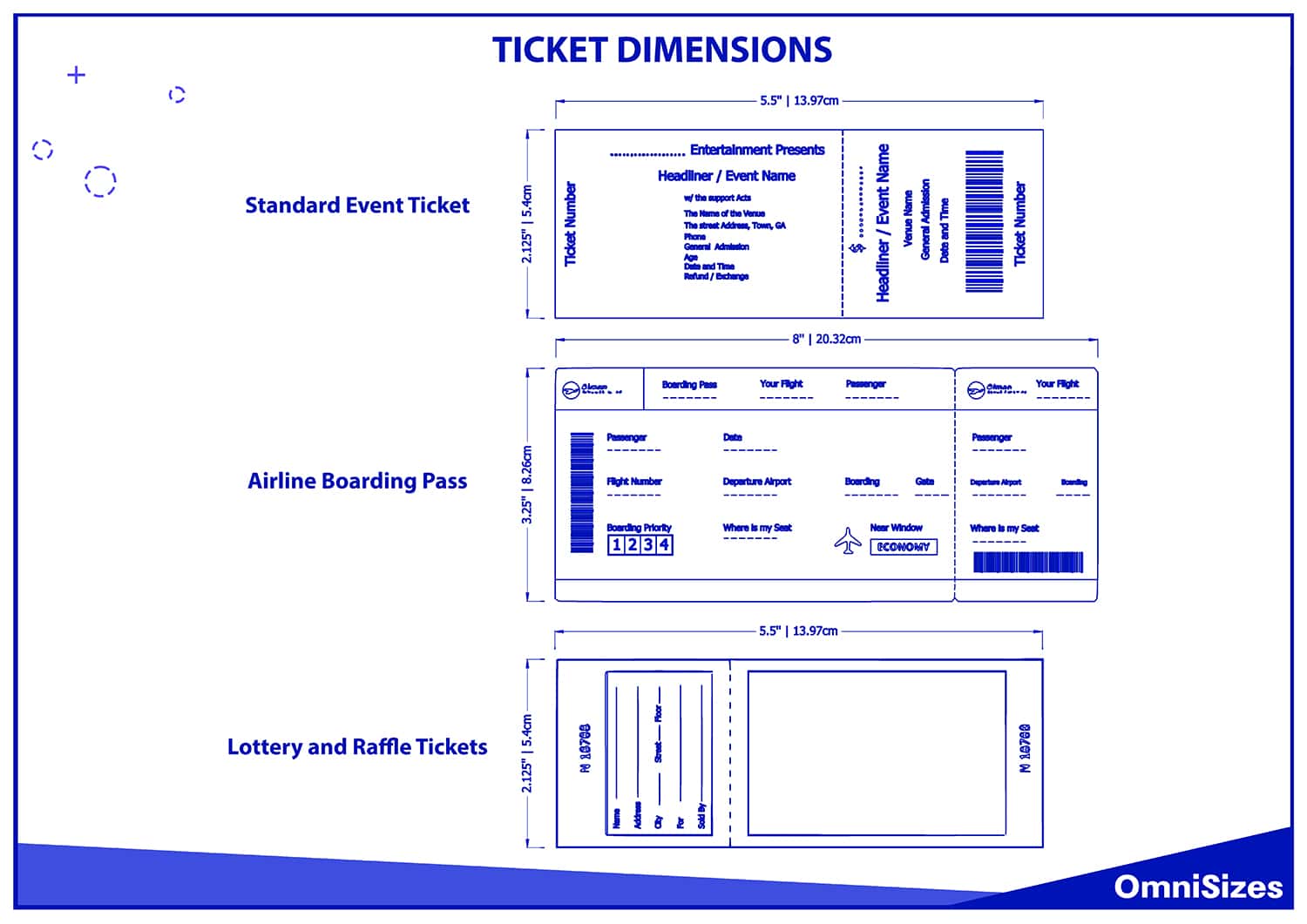Ticket dimensions have been a topic of interest, especially those in the event and transportation sectors. These dimensions not only impact the design and presentation of tickets but also play a vital role in logistics, storage, and distribution.
Typically, the dimensions of tickets vary depending on their purpose. For instance, a standard event ticket might measure around 2.125″ x 5.5″ (5.4 × 13.97 centimeters), while an airline boarding pass could be 3.25 × 8 inches (8.26 × 20.32 centimeters). These dimensions can differ based on region, type of event, or mode of transport.
This guide will quickly cover why ticket sizes matter in the first place, the various ticket dimensions based on type, and how physical and digital tickets differ.
This article delves deep into the world of ticket dimensions, exploring their history, variations, technological influences, and what the future might hold.

Why Does Ticket Size Matter?
Ticket size might seem like a trivial detail at first, but it holds considerable significance in various industries.
1. Usability and Convenience
The size of a ticket plays a role in how easily it can be handled, stored, and used. A ticket that is too large might be cumbersome to carry around, while one that’s too small can easily be lost. Think about concertgoers trying to keep track of their admission slips or travelers managing multiple boarding passes.
2. Design and Visibility
A ticket’s dimensions provide a canvas for designers. Larger tickets can accommodate more design elements, graphics, and detailed information. On the other hand, smaller tickets require a more minimalistic approach. A well-designed ticket can stand out, making it a memorable keepsake for events like music festivals or sports matches.
3. Security Features
Incorporating security features into tickets is easier when there’s ample space. Features like holograms, barcodes, and magnetic strips need sufficient room. With fraud and duplication being concerns, especially for high-profile events, having the right ticket size can aid in integrating these protective elements.
4. Technological Adaptations
With the rise of digital tickets, the ‘size’ now also refers to file size and display dimensions on screens. Mobile phones and other electronic devices display e-tickets, and the dimensions need to be compatible with various screen sizes for easy scanning and verification.
5. Cost Implications
The size of a ticket directly affects production costs. Bigger tickets might use more material and ink, increasing the production price. Additionally, the distribution of larger tickets might incur higher postage or shipping fees. Event organizers and transportation agencies often factor in these costs when deciding on ticket dimensions.
Different Types of Tickets and Their Dimensions
When you think of a ticket, various images might come to mind, from a sleek airline boarding pass to a colorful concert stub. Each ticket type is crafted with specific dimensions to serve its purpose effectively.
1. Event Tickets
- Sports Events: These tickets are often designed to be both functional and memorable. Standard dimensions hover around 2.125″ x 5.5″ (5.4 × 13.97 centimeters), offering ample space for team logos, seating details, and event information. Collectors might even keep them as souvenirs after the game.
- Concerts: With music lovers eager to remember their experiences, concert tickets frequently come adorned with artist graphics and tour details. They typically measure 2 × 6 inches (5.08 × 15.24 centimeters) to accommodate vivid designs without being too bulky.
- Theaters: For plays, musicals, and ballets, tickets often lean towards elegance. A standard size for theater tickets is around 2.125″ x 5.5″ (5.4 × 13.97 centimeters), providing space for show details while fitting easily into playbills or wallets.
2. Transportation Tickets
- Airlines: Boarding passes are one of the most recognizable tickets. They often come in a long, slender design, averaging 2.75 × 8.5 inches (6.99 × 21.59 centimeters). This size allows for passenger information, flight details, and barcodes to be displayed clearly.
- Trains: Train tickets can vary widely based on the railway system and region. However, a common dimension is 2.1 × 3.3 inches (5.33 × 8.38 centimeters), balancing portability with clarity for essential travel data.
- Buses: Bus tickets, especially for long-distance travel, often resemble train tickets in size. Many measure about 3.5 × 2 inches (8.89 × 5.08 centimeters), making them easy to handle during boarding processes.
3. Lottery and Raffle Tickets
Winning big might be the dream, but before that, you’ll handle a ticket. These tickets are often smaller, with dimensions around 2 × 5.63 inches (5.08 × 14.3 centimeters). This size is compact enough for mass distribution, and many come with perforations for easy tearing.
4. Festival and Fair Passes
These tickets are all about fun and often come with vibrant designs. Many festivals and fairs opt for wristbands, eliminating size concerns. However, paper passes or cards might measure around 3 × 4 inches (7.62 × 10.16 centimeters), providing room for event graphics and attendee details.
5. Museum and Attraction Tickets
When visiting a museum or tourist attraction, tickets serve as both entry passes and mementos. Often, they’ll measure about 2.5 × 6 inches (6.35 × 15.24 centimeters), allowing for venue details, visitor guidelines, and captivating images of exhibits or highlights.
Physical vs. Digital Tickets
Traditional paper tickets find themselves competing with their electronic counterparts, with both having their advantages and quirks.
| Feature | Physical Tickets | Digital Tickets |
| Dimensions & Portability | Varied sizes; can be stored in wallets or kept as souvenirs. Risk of loss or damage. | Formatted for device screens; stored in apps or digital wallets. Less risk of misplacement. |
| Design & Aesthetics | Defined canvas; tactile experience. Often kept as keepsakes. | Visually appealing with graphics; can be updated in real-time. |
| Security & Validation | Use of holograms, barcodes. Validated by stamping, tearing, or scanning. | Uses QR codes or digital barcodes. Real-time updates prevent duplication. |
| Environmental Impact | Production consumes resources; potential for waste. | Eco-friendly; eliminates paper and reduces waste. |
| Cost & Distribution | Production, printing, and distribution costs. Potential shipping fees. | Swift and cost-effective. No printing or shipping costs. |
| Flexibility & Updates | Static details; updates communicated separately. | Highly adaptable; real-time updates can be pushed to attendees. |






